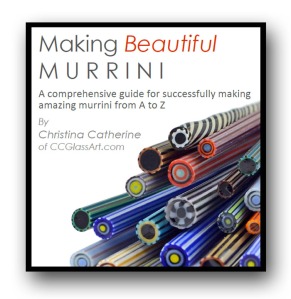
MAKING BEAUTIFUL MURRINI” Step-by-Step Tutorial
by Christina Catherine of CCGlassArt
Includes:
**Over 100 color photographs**
**More than 50 pages of instruction**
**Four murrini recipes including my super popular Starlight Murrini recipe**
**A Torch-Side Reference Guide**
…and SO much more!!
This tutorial is for every lampworker who has wanted to make murrini but didn’t because they were intimidated by the process, or perhaps has tried making murrini – spending many hours at the torch and using up lots of glass – only to be disappointed with the end result.
I was one of those lampworkers myself. I spent more hours and wasted more glass than I care to admit making hundreds of murrini canes with nothing worth using to show for it. Until, after much trial and error, I finally developed a fool-proof method and a series of reliable techniques, tips and tricks that helped me produce consistent results every time.
Once you learn to successfully make your own murrini cane the sky’s the limit! You can make custom designs anytime you want, in any colors you want. You can make murrini specifically for the style of beads you create.
You will be able to set your beads apart from the crowd making them more unique and individualized with murrini in color combinations and patterns you develop that are unavailable anywhere else.
You can even sell or share your extra murrini with other lampworkers (or fusers)!
Topics covered this tutorial include:
*Learn to create a 5 layer murrini design with up to 24 outer stripes (that will look like 48!)
*Choosing the best colors (I use COE 104 but you can easily adapt these tips and techniques to other COE glass)
*How to know which colors will work well together (and which colors to avoid)
*The entire process of making murrini cane from start to finish, step-by-step
*How to remove trapped air bubbles from encasing
*Getting multiple stringer lines spaced evenly and straight all the way around
*What to do when your stringer pops off unexpectedly
*Pulling the cane to a uniform diameter
*What to do with waste glass leftover from making murrini cane
*How best to apply murrini chips to your beads
…and tons more…
Making murrini can be intimidating but it doesn’t have to be. When broken down into easy-to-follow instructions, (with color photos guiding you every step of the way), you will have all the information you need – and the confidence – to successfully create beautiful, miniature designs in murrini that will take your beads to the next level.
This tutorial is written with the intermediate to advanced glass artist in mind who is well familiar with all aspects of lampworking including working with an open flame, melting glass rods, all safety precautions, etc.
However, if you consider yourself a beginner and are thinking about purchasing this tutorial but are unsure if you will benefit from it, please contact me. I may be able to help you decide if this tutorial is right for you at your current level of experience. 🙂

 takes on whatever shape the mold happens to be. In my case I have a mold shaped like a flower with many ‘spokes’ to form indentations where I’ll add thin lines of color to create mulitple stripes on the outside of the murrini.
takes on whatever shape the mold happens to be. In my case I have a mold shaped like a flower with many ‘spokes’ to form indentations where I’ll add thin lines of color to create mulitple stripes on the outside of the murrini. Making my own murrini is something I’ve done for quite a while now, such as the simple
Making my own murrini is something I’ve done for quite a while now, such as the simple  black striped Raku/Chalcedony murrini seen in these photos.
black striped Raku/Chalcedony murrini seen in these photos. Another type of murrini I’ve recently made, that does not require the use of an optic mold, was a pretty flower murrini in California Poppy colors.
Another type of murrini I’ve recently made, that does not require the use of an optic mold, was a pretty flower murrini in California Poppy colors.
 BRONZE AGE – available till Sunday on eBay.
BRONZE AGE – available till Sunday on eBay.


